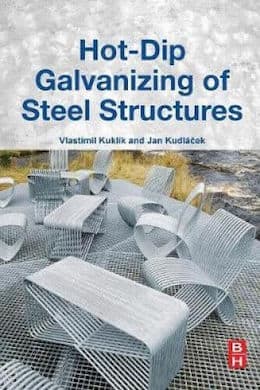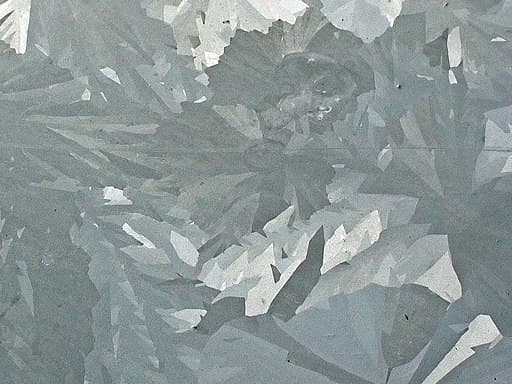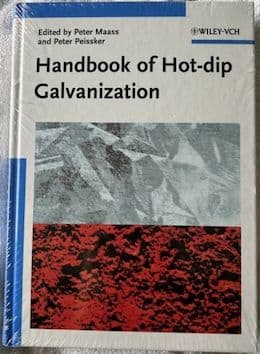
-----
Minimize/maximize spangle in hot dip galvanizing
November 1, 2021
I am trying to find galvanized sheets with a medium spangle. Is there an actual letter or number callout for it. Any idea where I can find something like 18 ga 4' x 8' sheets in a small quantity? I actually want to see if I would like it for trim on our rustic house. I also would like to age it quickly.
Thanks
Rick
Automatic gate fabricator and installer - Mead, Washington, USA
⇩ Related postings, oldest first ⇩
Q. I am process engineer and I am working in hot dip galvanizing line. According to the European regulation about less toxic products, the lead free galvanized steel is very recommended so my question is: there is hot dip galvanized steel with zero lead and if it is not correct what does lead-free mean (what is the % of lead in this case).
Mohamed MorsiKandil - Cairo, Egypt
2005
2005
A. If memory serves me, I believe "lead free" zinc means 0.05% or less in lead. To check look at the ASTM specs. or contact the American Galvanizers Association.
Regards,
Galvanizing Consultant - Hot Springs, South Dakota, USA
by Kuklik & Kudlacek

on eBay or Amazon
or AbeBooks
(affil link)
A. Lead free kettles are becoming increasingly more popular in the States. A big part of the reason is probably because of the new additions to the zinc bath in the last decade or so, most of which are supposed to help drainage of excess zinc as well as the appearance of the finished product (spangle, etc.). As far as what percentage is needed to be called "lead free", the first step is to add special high grade only to your bath.
You can look up nsf.org to see what it takes in the U.S. to get a certification for galvanizing food grade items. Their specs will give you a good idea of where you need to be. You will then need to get an analysis of your bath and decide what you need to do to get your existing inventory in your kettle right.
Houston, Texas
2005
A. I'm working about 6 years in galvanizing line as a shift foreman and what I know is lead is better to be between .025-.035%. More than 0.04 will reduce adhesion or sticking of coating, but even we have worked with .01% Pb and minimum spangle. But if you need spangle you have to charge 20 kg antimony (Sb) for 10 - 15 shifts keep Pb%+Sb%<.03
Jamal ashoorii- esfahan Iran
July 6, 2008
How to prep Land Rover parts for hot dip galvanizing
Q. I am rebuilding an old Land Rover, which has a lot of exposed, unpainted galvanized trim. I want to regalvanize everything with a nice spangle, not a big gloppy mess. Some parts have the original galvanizing, some are ungalvanized and have surface rust, some are painted, and some are newly fabricated parts. Should I sandblast everything back to bare steel? This will take me forever. Can I have things chemically dipped? Is it expensive?
Another question: I have some very small parts, about the size of a half dollar. Will a galvanizer do small parts like this? If not, is there a plating process that can give me something close to the look of galvanizing?
Thanks.
student - New Haven, Connecticut, USA
March 22, 2008
March 26, 2008
A. We do many Land Rover chassis for people who are refurbishing them. Here's the important points:
* All paint needs to be removed and blasting is the best way. Chemical dipping might work, but few galvanizers do this and most are uninterested in the process.
* Old galvanizing will come off in the pretreatment process. Some galvanizers will charge a little extra for that, as it consumes a lot of their acid, and adds zinc to it making it less easy to recycle. It's not possible to galvanize over existing galvanizing, as this is an alloying process between zinc and Iron. If the Zinc can't "see" the iron (because there's something in the way such as paint or old galv) it doesn't happen.
* Small parts can be done. Best done by "spinning", so ask if your galvanizer has a spinner, otherwise tie these bits on loosely (with mig welder wire or similar) to the bigger bits and they are less likely to go missing.
* It's rare for these parts to distort in my experience.
* Chassis not previously galvanized sometimes require vert/drain holes. The hollow sections will float, or retain zinc, or trap air - all leading to quality problems. So they need a hole to let air out then back in, let zinc in and out. But you get the same protection on the inside of the box section as the outside.
* Beware greasy buildup inside parts. It's got to be removed.
Good luck

Geoff Crowley
Crithwood Ltd.
Westfield, Scotland, UK

Q. Thanks Geoff,
Is there any way to ensure my parts have a nice spangle? I have seem a couple of these restorations that don't look so great due to poor galvanizing. Thanks.
- New Haven, Connecticut, USA
April 14, 2008
A. You probably won't get much spangle from a jobbing galvanizer, the zinc analysis isn't best for that. But spangle is only decorative and only lasts a short while, it has no influence on the corrosion protection - the real reason for using galvanizing. (If the spangle lasts a long time, then you didn't need to galvanize as its not corroding fast enough!)
Wonder what you mean by "poor" galvanizing. It's either there or it's not. It's not like some coatings where the coating is poorly adhered, etc. It's not so much a coating as an alloying reaction. If the steel isn't cleaned properly, then no reaction > no galvanizing.
Unless you mean drips, runs, ashy deposits, etc.
Even if you get these, they're easily rectified by filing (don't use an angle grinder).

Geoff Crowley
Crithwood Ltd.
Westfield, Scotland, UK

April 15, 2008
Multiple threads merged: please forgive chronology errors and repetition 🙂
Is lead required if we want spangle?
Q. Hi my name is Ray
I am being told by a supplier that we can no longer get a spangled finish on our galvanised steel strip as the manufacturer has reduced the lead content in the galvanising process.
Is this the case (as after a bit of research I believe that he is trying to supply us with galvannealed strip as a substitute) ?
Production Engineer - Birmingham
May 9, 2008
A. Dear Sir
According to my knowledge and my experience Addition of Lead is really helpful after melt-out stage for increasing the life of kettle, also decreasing the viscosity. Only Tin is for formation of spangle due to intergranular structure.

Hakan Esen, Material Engineer(BSc.)
galvanizing plant manager - Bursa, Turkey
May 12, 2008
May 15, 2008
A. Sir:
Lead, bismuth, and tin all produce spangle (zinc crystals) on hot dip galvanized steel. Lead is being used less due to environmental (toxic) reasons. One client that I have says that bismuth caused terrific "white" rust (They are a boat trailer manufacturer.). Tin causes a much smaller spangle and at levels higher than about 0.3% in the zinc causes stressed steel structures to crack. Also the steel wires used to hang the steel crack and break if the tin is too high. Usual additions of these metals to the zinc melt are: Lead about 1%; Bismuth about 0.1%; and Tin about 0.1% to about 0.2%. Excessive tin (about about 0.3%) has, in my opinion, been very, very bad for the galvanizing industry and for the safety of the public.
Regards,
Galvanizing Consultant - Hot Springs, South Dakota, USA
Multiple threads merged: please forgive chronology errors and repetition 🙂
How to minimize spangle
Q. Dear all:
Could you please help me how I am going to minimize spangles?
Thank you.
Galvanizing - Saudi Arabia
January 7, 2009
|
Regards,  Ted Mooney, P.E. Striving to live Aloha finishing.com - Pine Beach, New Jersey Ted is available for instant help or longer-term assistance. |
A. Sir:
For general after-fab galvanizing minimize zinc additions of lead, tin, and bismuth.
Regards,
Galvanizing Consultant - Hot Springs, South Dakota, USA
Q. One of our clients, a steel industry don't want spangles on the galvanized material. Our Pb content is 0.44 % and pot temperature is 450 °C. Please help me how I am going to reduce or eliminate completely.
We already mix our kettle with N2 gas...still spangle is visible.
dear all, please advice....
- Saudi Arabia
January 14, 2009
A. I found a reference that notes a .01% maximum for a coating to be considered lead free. Such coatings typically do not have a spangle finish unless antimony is added although antimony is not much better than lead. Non-spangle zinc coatings are widely used today. The reference can be found with search criteria: "lead-free" and galvanize.
Greg Hume- Cincinnati, Ohio
November 11, 2009
Q. Hi,
I have read a lot of Q&A on this site and gain good knowledge, Can you please tell me, How can we produce the spangles on iron/steel sheet. we are making a product in galvanized sheet and in the manufacturing process spangles remove, but we want spangles on it clearly. Is there any way to do the same.
Thanks
Vision Exports - Moradabad India
October 10, 2016
Q. After reading all comments I want to know what is the advantage and disadvantage of regular spangles and minimum spangles?
Which is better in corrosion resistance, painting,etc,?
Miraco Carrier - Cairo, Egypt
December 13, 2018
Q. Dear colleagues. The question of removing the crystallization pattern is still needed.
My question is what percentage of antimony should be in the zinc bath for the crystallization pattern on the steel strip?
- Temirtau, Kazahstan
October 7, 2019
A. Hi Nikolay. I know very little about galvanizing so I don't know if he's right, but if I understood correctly. for maximum spangle Jamal suggested adding 20 kg for 10-15 shifts, but ending up with <0.3% combined lead and antimony.
Regards,

Ted Mooney, P.E. RET
Striving to live Aloha
finishing.com - Pine Beach, New Jersey
Ted is available for instant help
or longer-term assistance.
October 2019
Flower in hot dip galvanising
Q. hello every one
I am a process engineer in a hot galvanizing industry in Tunisia, we galvanize small and large parts (more than 10 m) our black parts go through a pickling of hydrochloric acid then rinsing then double salt flow, and finally we add in the zinc bath every 3 days 4 tons of zinc and 400 kg lead and 3 kg aluminum, the problem is that our quality does not contain flowers as we want, my question is how much lead, aluminum I must add to the bath to obtain a better quality with flowering (our bath is 10m long, 2m wide and 1.5m high).
I would be very happy if you help me and thanks in advance.
engineer - tunisia
March 18, 2020
A. Hi mohamed. I'm not familiar with the term "flower" as related to galvanizing, but from context I'm guessing you refer to what I call 'spangle'?

Regards,

Ted Mooney, P.E. RET
Striving to live Aloha
finishing.com - Pine Beach, New Jersey
Ted is available for instant help
or longer-term assistance.
March 2020
A. Spangle (or "flower" as you call it, is a crystalline pattern formed during solidification of the zinc during alloying/galvanizing. It is more dependent on the steel thickness and chemistry than it is on the chemistry of your zinc. The Pb you add, won't make much difference, it has low solubility in Zn, and any excess sinks to the bottom of the kettle. Al can make for brighter galvanizing and larger spangle, but excess Al causes other problems, and levels around 0.001 to 0.003% are about the limits of normal operation.
Thin steel spangles easier, with a thinner galvanized coating. Thick steel rarely spangles.
Spangle can be present at the start, bu8t not visible and over many tears of weathering becomes visible.
Spangle is no indication of quality, longevity or any other desirable aspect other than perhaps some people like its aesthetic. It doe not indicate any functional quality.

Geoff Crowley
Crithwood Ltd.
Westfield, Scotland, UK

March 19, 2020
Q, A, or Comment on THIS thread -or- Start a NEW Thread

